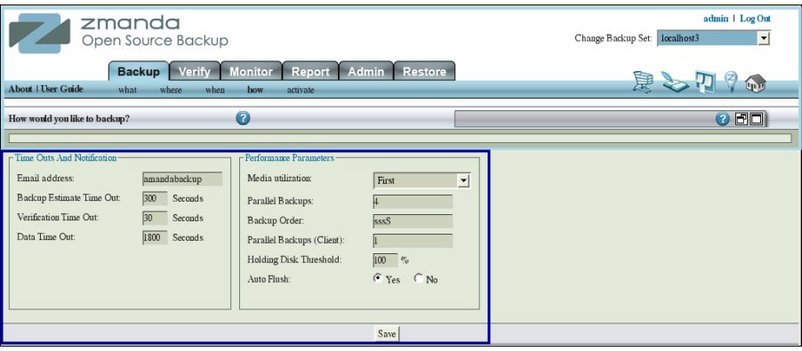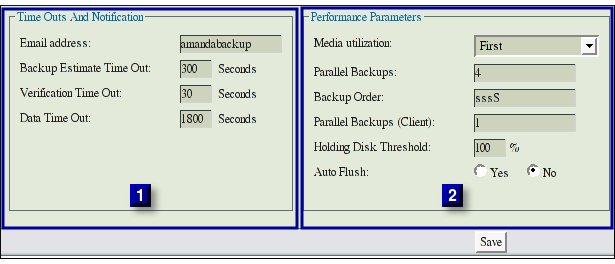Zmanda Documentation > BackupHow
Table of contents
- 1. Introduction
- 2. Backup How Page Overview
- 3. Backup How Page Main Functionality
- 4. Time Outs & Notification Parameters
- 4.1. Mail Address
- 4.2. Backup Estimate Time Out
- 4.3. Verification Time Out
- 4.4. Data Time Out
- 5. Performance Parameters
- 5.1. Media Utilization
- 5.2. Parallel Backups
- 5.3. Backup Order
- 5.4. Parallel Backup Clients
- 5.5. Holding Disk Threshold
- 5.6. Auto Flush
- 6. Save Button
- 7. Move to...
BACKUP HOW
Introduction
- Users will have already defined What is to be backed up, Where it is to be backed up and When it is to be backed up before reaching the Backup How page.
- The Backup How page exposes some of the key internal parameters that control how the Backup Set will run after it has been activated.
- ZMC has been designed in such a manner that the default values set for the parameters will work well for most Backup Sets. Ordinarily, they need not be changed.
- Advanced users looking to change the default values should study the logs of a few past backup runs in light of the discussion that follows.
Backup How Page Overview

- Explanation of common functionalities enclosed in a light blue rectangle at the top in Fig 1 can be found on the Common Functionality page.
- In the image above, the main functionality area is enclosed in the lower Navy Blue rectangle.
Backup How Page Main Functionality
- The main functionality of the Backup How page is to allow users to set parameters that control how backup runs will be performed.
- The left hand panel (No. 1 below) allows users to change backup timeouts and notification parameters.
- The right hand panel (No. 2 below) allows users to change backup parameters that impact the backup window.
WARNING: Users should not simultaneously modify the parameters directly in the Amanda configuration file and ZMC. Before modifying the Amanda configuration file directly, users should log out of their ZMC session.
Time Outs & Notification Parameters

- The Left Hand panel (No. 1) on the Backup How page contains the Time Outs and Notifications parameters that display their default values.
Mail Address
- This parameter sets the Email address of the Amanda backup administrator.
- Though this is an optional parameter, it is important to set the Notification parameter to the email address(es) of the Amanda administrator. Amanda backup run notifications will be sent to the email address.
- The email address can be different from the email address set in the Admin page for a particular user.
- ZMC also provides content of the notification in the Report Summary page for the Backup Set.
- The Mail user agent (MUA) such as Mail should be configured on the Amanda server before any email can be sent. *ZMC does not install or configure the MUA.
Backup Estimate Time Out
- Backup Estimate Time is the first phase (Planning phase) of the backup process.
- The Amanda backup process involves estimation of backup size for each DLE configured in the Backup Set.
- The backup size estimation for all DLEs in the Backup Set is done in parallel.
- Users can specify a time out (in Seconds) by which each Amanda client has to respond with a backup size estimate.
- If the time out occurs for a particular DLE , that DLE will not be backed up during the backup run.
- Amanda will perform a full backup for the DLE in the next backup run.
- The time out specified should take into account factors like clients with limited network bandwidth, limited CPU, multiple DLEs on one host and clients with large amounts of data to be backed up.
- Some idea of the time being taken to perform size estimates can be had from the Monitor page where details of the current backup run are displayed.
- A much better idea can be had from the Report Time line page where DLE-wise details are displayed.
- If a DLE has been timed out, it will be displayed in red. Other DLEs are displayed in green.
Verification Time Out
- ZMC allows users to verify configuration of the Amanda client on the Verify Client page.
- Verification Time out controls the time (in Seconds) that the verification tool waits for the client to respond to verification requests.
- The time out may be adjusted for clients with limited network bandwidth.
- If the time out expires, the verification of the client fails.
- This time out has no impact on the backup process. If the client is properly set up, it will be backed up.
- The time out is applicable for all clients in the backup set.
Data Time Out
- Data Time Out determines the time (in Seconds) that the Amanda server will wait (during the backup execution phase) for a client to begin to respond to a backup request.
- If data time out occurs for a client, the backup of all directories for the client is not done in the backup run. The directories on the client will be backed up in the next backup run.
- The time out may be adjusted for clients with limited network bandwidth.
- The time out is applicable for all clients in the backup set.
Performance Parameters
- The Performance Parameters are grouped in the Right Hand panel (No. 2) labeled as such.
Media Utilization
- A holding disk is written in parallel. By the time the first completed DLE backup has been written to the media, many more DLEs backups may also be ready to be moved.
- This parameter sets the algorithm that determines the order in which the completed backup images are moved from holding disk to the backup media.
- Only completed backup images on the holding disk are considered for moving.
- The ordering of the images can help in better utilization of backup media.
- Options are:
- First: (Default value) First in - first out.
- Firstfit: The first backup image that will fit on the current media volume.
- Largest: The largest backup image first.
- Largestfit: The largest backup image that will fit on the current media volume.
- Smallest: The smallest backup image first.
- Last: Last in - first out.
Parallel Backups
- This parameter sets the number of parallel data backups that are performed from the Amanda clients to the holding disk in a backup run.
- The default value is 10.
- How many parallel backups happen to the holding disk depends on
- CPU and Write speed on the Amanda server
- Network configuration between the Amanda server and Amanda client
Backup Order
- Whenever two or more parallel streams want to write at the same time to a media, there is a potential conflict, i.e which stream should be allowed to write first.
- The users can assign priority to each of the parallel backup processes, the number of which is determined by the value of "Parallel Backups" field.
- The possible option choices and what they mean is indicated below:
- s -> smallest size first
- S -> biggest size first
- t -> smallest time first
- T -> biggest time first
- b -> smallest bandwidth first
- B -> biggest bandwidth first
- Try "BTBTBTBTBTBT" if the user is not holding disk constrained
Example 1 : A string like "sssS" which represents the priority order for four parallel backups indicates that
three dumpers will seek the smallest size hosts while one dumper will seek the biggest size host to backup.
Example 2 : A string like 'BbsTt' indicates there are five parallel backup process of which: One backup process(B) is looking for the Biggest Bandwidth occupying backups. Another backup process(b) is looking for the smallest Bandwidth occupying backups. Another backup process(s) is looking for the smallest size backups. Another backup process(T) is looking for biggest Time occupying backups. Another backup process(t) is looking for smallest Time occupying backups.
Parallel Backup Clients
- The parameter sets the Number of parallel backups performed from an Amanda client.
- The default value is 1 meaning that Backups of all DLEs on a client is done sequentially.
- If an Amanda client has sufficient CPU and network resources, multiple DLEs on the client could be backed up in parallel.
Holding Disk Threshold
- When space on a holding disk falls below a threshold size (the value of this parameter), the Amanda does only incremental backups to conserve holding disk space.
- 20% value means Amanda will only do incremental backups when holding disk(s) free space falls below 20%.
- When there is a media error during a backup run, the backup images are still stored in holding disk.
- Amanda allows recovery from holding disk and backup media.
Auto Flush
- This parameter determines whether Amanda should flush the backup images from the holding disk to the backup media before a backup run.
- The default value is Yes.
- Users can monitor this activity in the ZMC Monitor page.
Save Button
- Users should save changed parameters by clicking Save button before going to another page.
- Parameters can be changed even when a backup run is in progress and the change will not have impact on the active backup run.
- All changes will affect the next backup run.
Move to...
- If the Backup Set has not been activated (scheduled), users should go Backup Activate page.
